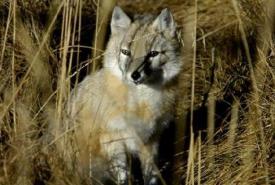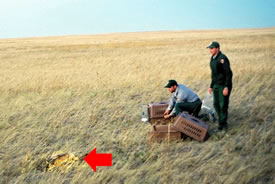The swift fox: A conservation success story

Swift fox (Photo by Karol Dabbs)
Although I work as the Nature Conservancy of Canada's (NCC's) conservation coordinator responsible for the area in Alberta where swift foxes now live, I have never seen a wild one myself. These are elusive creatures. I did see several being released, and they certainly disappeared very quickly!
The swift fox is a real conservation success story. Mr. and Mrs. Smeeton, of the Cochrane Ecological Institute, spearheaded the recovery effort in cooperation with a partnership of various conservation agencies. This project is considered the most successful reintroduction of a canid in the world.

Swift fox release by USFWS (Photo by Corlaine Gardner)
Swift foxes are nocturnal, and hide in unused badger holes during the day. They eat mammals almost exclusively: mice and especially jackrabbits. They don’t seem to eat ground squirrels much, perhaps because the ground squirrels are active only during the day. Their predators include coyotes and golden eagles.
The swift fox’s restored range includes the prairie of southeastern Alberta, south of the Cypress Hills. This large swath of native grassland has little influence from people, so it is a perfect place for them.
Over the past 15 years, swift fox numbers have steadily increased. They now range from near Foremost, Alberta east to Grasslands National Park in Saskatchewan. They have expanded their territory south into Montana, although no animals were released in the United States. As of 2006, their population numbers over 1,100 individuals.
Despite its elusive nature, we do know that the swift fox is present on some NCC lands at the northern edge of the species' range. One swift fox was seen at NCC’s Haugan Property, near Manyberries, Alberta. In Saskatchewan, NCC has several properties, including Old Man On His Back, that provide excellent habitat for swift fox.
NCC staff in Alberta and Saskatchewan are currently creating a conservation plan for this region. When completed, it will guide NCC’s efforts to conserve the swift fox and the area’s many other threatened wildlife species.


